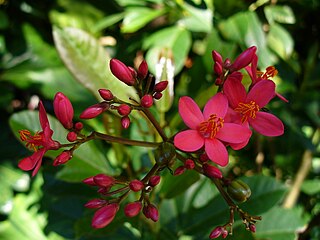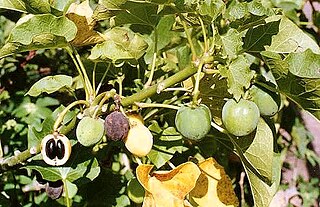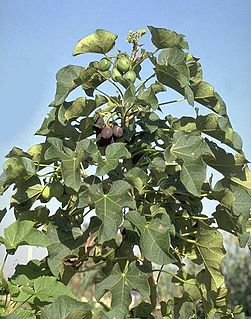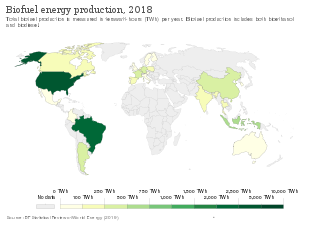
Biofuel is fuel that is produced through contemporary processes from biomass, rather than by the very slow geological processes involved in the formation of fossil fuels, such as oil. Since biomass technically can be used as a fuel directly, some people use the terms biomass and biofuel interchangeably. More often than not, however, the word biomass simply denotes the biological raw material the fuel is made of, or some form of thermally/chemically altered solid end product, like torrefied pellets or briquettes.

Biodiesel is a form of diesel fuel derived from plants or animals and consisting of long-chain fatty acid esters. It is typically made by chemically reacting lipids such as animal fat (tallow), soybean oil, or some other vegetable oil with an alcohol, producing a methyl, ethyl or propyl ester.

Jatropha is a genus of flowering plants in the spurge family, Euphorbiaceae. The name is derived from the Greek words ἰατρός (iatros), meaning "physician", and τροφή (trophe), meaning "nutrition", hence the common name physic nut. Another common name is nettlespurge. It contains approximately 170 species of succulent plants, shrubs and trees. Most of these are native to the Americas, with 66 species found in the Old World. Plants produce separate male and female flowers. As with many members of the family Euphorbiaceae, Jatropha contains compounds that are highly toxic. Jatropha species have traditionally been used in basketmaking, tanning and dye production. In the 2000s, one species, Jatropha curcas, generated interest as an oil crop for biodiesel production and also medicinal importance when used as lamp oil; native Mexicans in the Veracruz area developed by selective breeding a Jatropha curcas variant lacking the toxic compounds, yielding a better income when used as source for Biodiesel, because of its edible byproduct. Toxicity may return if edible Jatropha is pollinated by toxic types.

Camelina is a genus within the flowering plant family Brassicaceae. The Camelina species, commonly known as false flax, are native to Mediterranean regions of Europe and Asia. Most species of this genus have been little studied, with the exception of Camelina sativa, historically cultivated as an oil plant. Heinrich Johann Nepomuk von Crantz was the first botanist to use the genus Camelina in his classification works in 1762. As a way to reduce fossil fuel emissions, the US Navy tested a 50-50 mix of jet aviation fuel and biofuel derived from camelina seeds in 2010. A study published in December 2016 explained that the current low price of conventional kerosene-based jet fuel makes it cost-prohibitive for commercial airlines to use camelina-based jet fuel. The study said substantial government intervention would be one way to create a market for camelina, by combining 9 percent government subsidy on camelina crop production, with 9 percent tax on the conventional fuel.

Camelina sativa is a flowering plant in the family Brassicaceae and is usually known in English as camelina, gold-of-pleasure, or false flax, also occasionally wild flax, linseed dodder, German sesame, and Siberian oilseed. It is native to Europe and to Central Asian areas. This plant is cultivated as oilseed crop mainly in Europe and in North America.

This article describes the use and availability of biodiesel in various countries around the world.

Biofuel development in India centres mainly around the cultivation and processing of Jatropha plant seeds which are very rich in oil (40%). The drivers for this are historic, functional, economic, environmental, moral and political. Jatropha oil has been used in India for several decades as biodiesel for the diesel fuel requirements of remote rural and forest communities; jatropha oil can be used directly after extraction in diesel generators and engines. Jatropha has the potential to provide economic benefits at the local level since under suitable management it has the potential to grow in dry marginal non-agricultural lands, thereby allowing villagers and farmers to leverage non-farm land for income generation. As well, increased Jatropha oil production delivers economic benefits to India on the macroeconomic or national level as it reduces the nation's fossil fuel import bill for diesel production ; minimising the expenditure of India's foreign-currency reserves for fuel allowing India to increase its growing foreign currency reserves. And since Jatropha oil is carbon-neutral, large-scale production will improve the country's carbon emissions profile. Finally, since no food producing farmland is required for producing this biofuel, it is considered the most politically and morally acceptable choice among India's current biofuel options; it has no known negative impact on the production of the massive amounts grains and other vital agriculture goods India produces to meet the food requirements of its massive population. Other biofuels which displace food crops from viable agricultural land such as corn ethanol or palm biodiesel have caused serious price increases for basic food grains and edible oils in other countries.

Energy crops are low-cost and low-maintenance crops grown solely for energy production by combustion. The crops are processed into solid, liquid or gaseous fuels, such as pellets, bioethanol or biogas. The fuels are burned to generate electrical power or heat.
The United States produces mainly biodiesel and ethanol fuel, which uses corn as the main feedstock. The US is the world's largest producer of ethanol, having produced nearly 16 billion gallons in 2017 alone. The United States, together with Brazil accounted for 85 percent of all ethanol production, with total world production of 27.05 billion gallons. Biodiesel is commercially available in most oilseed-producing states. As of 2005, it was somewhat more expensive than fossil diesel, though it is still commonly produced in relatively small quantities.

Biofuel is fuel that is produced from organic matter (biomass), including plant materials and animal waste. It is considered a renewable source of energy that can assist in reducing carbon emissions. The two main types of biofuel currently being produced in Australia are biodiesel and bioethanol, used as replacements for diesel and petrol (gasoline) respectively. As of 2017 Australia is a relatively small producer of biofuels, accounting for 0.2% of world bioethanol production and 0.1% of world biodiesel production.

Jatropha curcas is a species of flowering plant in the spurge family, Euphorbiaceae, that is native to the American tropics, most likely Mexico and Central America. It is originally native to the tropical areas of the Americas from Mexico to Argentina, and has been spread throughout the world in tropical and subtropical regions around the world, becoming naturalized or invasive in many areas. The specific epithet, "curcas", was first used by Portuguese doctor Garcia de Orta more than 400 years ago. Common names in English include physic nut, Barbados nut, poison nut, bubble bush or purging nut. In parts of Africa and areas in Asia such as India it is often known as "castor oil plant" or "hedge castor oil plant", but it is not the same as the usual castor oil plant, Ricinus communis.
China has set the goal of attaining one percent of its renewable energy generation through bioenergy in 2020.

Algae fuel, algal biofuel, or algal oil is an alternative to liquid fossil fuels that uses algae as its source of energy-rich oils. Also, algae fuels are an alternative to commonly known biofuel sources, such as corn and sugarcane. When made from seaweed (macroalgae) it can be known as seaweed fuel or seaweed oil.

Sustainable biofuel is biofuel produced in a sustainable manner.

An aviation biofuel or bio-jet-fuel or bio-aviation fuel (BAF) is a biofuel used to power aircraft and is said to be a sustainable aviation fuel (SAF). The International Air Transport Association (IATA) considers it to be one of the key elements to reduce the carbon footprint within the environmental impact of aviation. Aviation biofuel could help decarbonize medium- and long-haul air travel generating most emissions, and could extend the life of older aircraft types by lowering their carbon footprint.

The use of biofuels varies by region. The world leaders in biofuel development and use are Brazil, United States, France, Sweden and Germany.

Global Clean Energy Holdings (OTC:GCEH) is a Southern California-based renewable energy company focused on the production and commercialization of non-food based feedstocks used for the production of biofuels, biomass and renewable chemicals.

Kamrun Nahar is a Bangladeshi soil scientist and environmentalist. A prominent biofuels researcher of Bangladesh, her research and publications also aimed to lower dependence on petroleum based foreign oil by producing low carbon and sulphur emitting biofuels from the second generation energy crops cultivated in the unused wastelands of Bangladesh for use in home generators to supplement power.
Sustainable Oils is a Seattle-based renewable fuels company specializing in the research and production of Camelina, the only advanced biofuels feedstock with United States Department of Agriculture, Environmental Protection Agency, and Food and Drug Administration (FDA) regulatory approvals. Oil extracted from Camelina seeds can be processed into a number of renewable products including renewable jet fuel, green diesel, biodiesel, green plastics and renewable oleochemicals. The biomass that remains after oil extraction, generally referred to seedcake or meal, can be used as nutrient-rich animal feed. Camelina offers several advantages over traditional biofuel feedstocks like soy and corn, such as competitive oil yields and shorter growing seasons. Sustainable Oils has its primary operations in the state of Montana.















